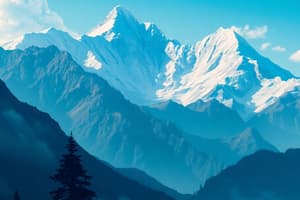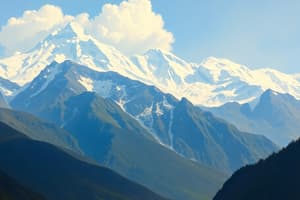Podcast
Questions and Answers
Human geography examines how physical geography impacts human activity.
Human geography examines how physical geography impacts human activity.
True (A)
What did Katharine Lee Bates write after seeing the view from Pikes Peak?
What did Katharine Lee Bates write after seeing the view from Pikes Peak?
- The Star-Spangled Banner
- This Land Is Your Land
- America the Beautiful (correct)
- My Country, 'Tis of Thee
What was the goal of NASA's Apollo program?
What was the goal of NASA's Apollo program?
To land men on the moon and return them to Earth.
What is the Overview Effect?
What is the Overview Effect?
The Earth is the ___ planet from the sun.
The Earth is the ___ planet from the sun.
What makes Earth the 'Goldilocks planet'?
What makes Earth the 'Goldilocks planet'?
About 71 percent of Earth's surface is covered with land.
About 71 percent of Earth's surface is covered with land.
What does Earth's magnetic field protect against?
What does Earth's magnetic field protect against?
Which planet has the most moons?
Which planet has the most moons?
What is one of the impacts of natural disasters according to the text?
What is one of the impacts of natural disasters according to the text?
Flashcards are hidden until you start studying
Study Notes
Human Geography and Its Impact
- Human geography analyzes how physical geography influences human activities and vice versa.
- Geography shapes culture, language, economics, urban and rural life, politics, and international relations.
- Understanding geography aids in comprehending the interconnectedness of nearly eight billion people.
Curriculum Goals
- Aim to perceive the earth and its creation in a new light, recognizing its connection to a higher purpose.
- Explore geography beyond physical features, emphasizing human geography and its relevance.
Historical Perspective on Earth Observation
- Early views of the earth came from mountaintops, balloons, and airplanes, culminating in the 1960s.
- Katharine Lee Bates wrote "America the Beautiful" inspired by the view from Pikes Peak.
- NASA's Lunar Orbiter 1 captured the first images of Earth in 1966.
The Space Race and Earth's Visibility
- Apollo 8's 1968 Christmas Eve broadcast displayed Earth from lunar orbit, highlighting its beauty.
- Neil Armstrong and Buzz Aldrin became the first humans on the moon in 1969, showcasing human ingenuity.
- "Blue Marble," taken by Apollo 17 in 1972, is among the most well-known images of Earth.
Overview Effect
- Astronauts report profound insights while viewing Earth from space, recognizing its fragility and unity.
- Reflects on global issues such as poverty and conflict among diverse nations and cultures.
Earth's Characteristics
- The sun is a central star in the Milky Way, with Earth as the third planet from it.
- Earth's average distance from the sun is about 93 million miles, ensuring stable temperatures suited for life.
- The unique attributes of Earth, including its atmosphere and water composition, make it conducive for maintaining life.
The Goldilocks Principle
- Earth is described as the "Goldilocks planet," perfect for sustaining life—not too hot, not too cold.
- The moon's distance from Earth influences tides and stabilizes its rotation, crucial for maintaining a suitable climate.
Atmospheric Conditions
- Earth's atmosphere supports life within a narrow band, predominantly composed of nitrogen and oxygen.
- Other planets, like Venus and Mars, lack optimal conditions for sustaining human life.
Interconnected Ecosystems
- Earth supports complex relationships among life forms, where animals and plants contribute to each other's survival.
- The existence of a diverse climate enables various ecosystems, enriching life experiences.
Natural Threats and Resilience
- Natural disasters (earthquakes, hurricanes, etc.) pose risks but can also rejuvenate ecological systems.
- Disasters create opportunities for community support and highlight the resilience of humanity.
Importance of Stewardship
- Acknowledges the responsibility of caring for Earth and respecting fellow inhabitants.
- Scripture emphasizes God as the Creator and underscores the importance of stewardship over the planet and its resources.
Assignments and Reflection
- Students encouraged to reflect on conflicts arising from differing perspectives.
- Engage in projects and readings to deepen understanding of worldview, including "Know Why You Believe."
Studying That Suits You
Use AI to generate personalized quizzes and flashcards to suit your learning preferences.




